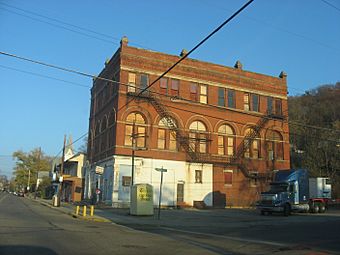Village of Addyston Historic District facts for kids
Quick facts for kids |
|
|
Village of Addyston Historic District
|
|

Downtown Addyston
|
|
| Location | Roughly along Main, Sekitan, Church, First and Second Sts., and Three Rivers Parkway, Addyston, Ohio |
|---|---|
| Area | 350 acres (140 ha) |
| Built | 1889 |
| Architectural style | Stick/Eastlake, Queen Anne |
| NRHP reference No. | 91001388 |
| Added to NRHP | September 13, 1991 |
The Village of Addyston Historic District is a special place in the village of Addyston, Ohio. It's located right along the Ohio River, not far from Cincinnati. This district is like a time capsule, showing us what life was like in two old "company towns." Most of the buildings here are homes, but you can also find some unique larger buildings.
What is a Company Town?
A company town is a place where a single company built most of the homes and businesses. They did this for their workers. Imagine a whole town built by one big factory! This meant the company often owned the houses, stores, and even the schools.
How Addyston Was Formed
Addyston started as two separate company towns in 1887. These were called Sekitan and East Addyston. They grew quickly until about 1900. In 1891, these two communities decided to join together and officially became the village of "Addyston."
Because they were company towns, most of the buildings looked very similar. East Addyston, especially, was almost all homes. Sekitan, which was older, had a few more unique buildings. Even after they merged, people still thought of them as separate places for a long time. They even had different post offices until the 1930s!
Exploring the Historic District
In 1991, a large part of Addyston was named a historic district. This means the area has special historical importance. Most of the buildings in the village are part of this district.
Many of the homes are simple, older houses built before 1930. You can also find some churches, community buildings, and shops. Most of these non-home buildings are in the western part of the district, where Sekitan used to be. The district includes 384 buildings. More than five out of every six buildings are considered "contributing properties." This means they help tell the story and history of the district.



